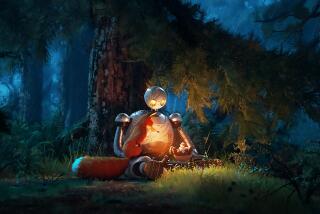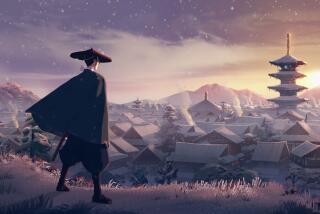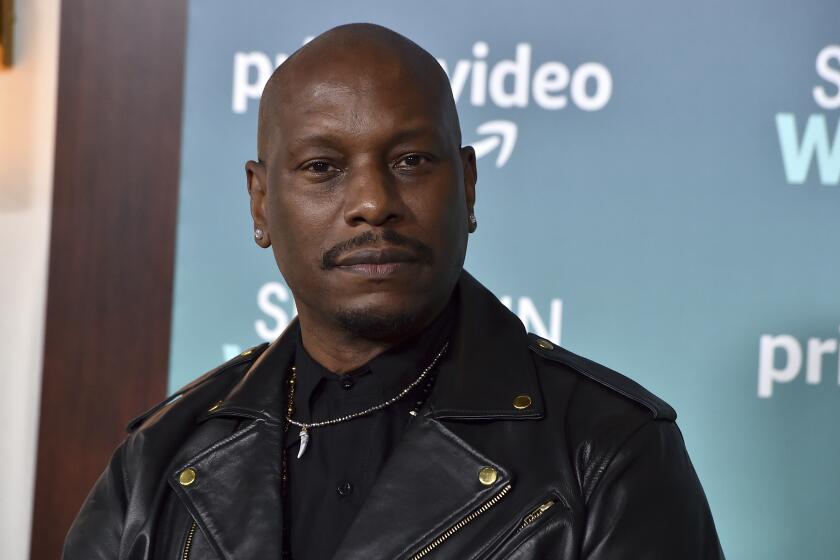The Animated Wonders of ‘Roger Rabbit’ : Movie Review: Feverishly Inventive Mix of Actors, Cartoon Characters
What’s amazing about “Who Framed Roger Rabbit” (selected theaters), a sort of inked-in film noir with outrageous sight gags, is how quickly we begin to accept the miracle in front of our eyes.
In less than four minutes we are introduced to a hapless “actor,” the (very) animated R. Rabbit himself, driving his human director nuts because Roger sees tweeting birds instead of stars when a refrigerator drops on his head.
Within 10 more minutes, we have accepted humans criss-crossing into Roger’s world, the second-class, metaphoric world of the Toons--animated stars, contract players and bit actors who work at Hollywood’s Maroon Studios in 1947. We believe that when a seedy gumshoe, Eddie Valiant (Bob Hoskins), walks onto the Maroon lot he has to squeeze by a tutu-ed Toon hippo on the stairs and avoid getting his feet wet as a squad of brooms from “Fantasia” scrub down a sound stage. (Hoskins must have a cast-iron imagination to carry off this delicately calibrated interaction with every size and variety of Toon, from a rabbit in his bed, to an 8-foot gorilla looming menacingly over his shoulder, to a seductress with Gloria Grahame’s mouth and Jayne Mansfield’s silhouette.)
Dense, satisfying, feverishly inventive and a technical marvel, “Who Framed Roger Rabbit” had Robert Zemeckis (“Back to the Future”) as its director and Richard Williams, an Academy Award winner for “A Christmas Carol” (1972), as director of animation, under the joined banners of Disney’s Touchstone and Steven Spielberg’s Amblin companies. All hands and the artists involved may have created a film that no one sees just once.
The original wild hare of an idea of mixing animated characters with real ones came from the 1981 novel “Who Censored Roger Rabbit?” by Gary K. Wolf, which has been overhauled by screenwriters Jeffrey Price and Peter Seaman until not very much is left of the plot but its premise.
It now sports a mystery story that owes something to the flavor of “Chinatown” and something more to the lore that surrounded the dismantling of Los Angeles’ superb electric Red Car system and the building of a freeway system to supplant it.
The script now presents Roger, a veteran Toon slapstick comic (given rich, flavorful voice by stand-up comic Charles Fleischer), hysterical because his luscious wife, Jessica (an uncredited vocal appearance by Kathleen Turner), a nightclub chanteuse, has been caught in some pretty incriminating photos with Marvin Acme (Stubby Kaye), novelty company maven. (Does Acme sound familiar? You’re remembering Wile E. Coyote’s supplier of dynamite sticks.)
What follow are bloodless murders (this is rated PG) and horrifying menace from the sinister Judge Doom (Christopher Lloyd), a live-action character attended by a vile band of cartoon weasels.
Doom’s weapon is The Dip, a fulminating mixture of turpentine and benzene, guaranteed to eradicate any winsome Toon it touches. (No one even has to mention The Final Solution.)
“Roger Rabbit” has a different fascination for each age. Kids will gawk at the trick itself, at animated penguin waiters balancing real trays and cartoon characters waving real guns, while Eddie Valiant loads Yosemite Sam’s whopping animated pistol whose bullets have faces and voices and a will of their own. And if, as kids sometimes do, they try to find a flaw in the execution, they won’t be able to. These Toons cast real shadows--in more than one sense of the word.
It isn’t hard to apply the Toons’ predicament to real life, to those once considered good enough to perform in clubs but not to eat or drink in them, whose choices were to be in the spotlight or in the kitchen; those who must live in sealed-off ghettos on land controlled by others. The film makers are well aware of the Toons’ symbolism, but they choose simply to show them, not preach about them.
For audiences who grew up with cartoons as a natural part of their moviegoing, the shock may not be the mix of live and animated folk--it may come from the truly revolutionary sight of great icons of rival studios cheerfully rubbing shoulders.
Imagine--Daffy and Donald Duck on twin pianos, and a studio big enough to have only superstars: Droopy and Dumbo, Bambi and Lena Hyena, Porky Pig and Pinocchio, Woody Woodpecker and Tweetie Pie, Bugs Bunny and Betty Boop. (Betty, bless her heart, remains faithful to her black-and-white beginnings.) Hog heaven for cartoon fans, it’s a coup roughly equivalent to Live Aid and a reunion of all the Beatles, combined.
Zemeckis has had careful hold of the thread of movie memory and cartoon delight that strings together all of “Roger Rabbit’s” action. The gags are rich and funny: The old chestnuts from Mae West and Kitty Foyle are reprised quite deliberately, and a few of the new gags are brilliant.
Best of those is Doom’s formula for luring any Toon out of hiding: He simply taps out “Shave and a haircut . . .” and waits for the answering “Two bits!” to reveal his victim. Roger twists like a corkscrew, trying to restrain himself on that one. Actually, there is something serious being said here about the life of a Toon (for which you might read actor ), who will do anything, even endanger his life, to get his laugh.
There are surprises and treasures at every turn, particularly for the movie buff. But--animation aside--the treasure of the piece is Hoskins’ pungent, visceral comic performance. No surprise to those who remember him singing and dancing in the complex and dark British TV tragicomedy “Pennies From Heaven,” Hoskins modulates his performance here from the subdued to the cartoon-manic to remain the absolute linchpin of the piece.
Scanning the last, great roundup of cartoon stars, you may notice a few pets missing, Popeye especially. You’ll see a tiny homage to Felix the Cat, also absent, over the tunnel to Toontown, with Felix as the masks of Comedy and Tragedy. The owners of Popeye and Felix reportedly sniffed at the $5,000 offered for their use.
In this historic constellation, you can’t help but feel it’s their loss.
‘WHO FRAMED ROGER RABBIT’
A Touchstone Pictures and Steven Spielberg presentation in association with Silver Screen Partners III of a Robert Zemeckis film distributed by Buena Vista Pictures Distribution Inc. Executive producers Spielberg, Kathleen Kennedy. Producers Robert Watts, Frank Marshall. Director Zemeckis. Screenplay Jeffrey Price & Peter S. Seaman, based on the book “Who Censored Roger Rabbit?” by Gary K. Wolf. Director of animation Richard Williams. Camera Dean Cundey. Editor Arthur Schmidt. Production design Elliot Scott with Roger Cain. Music Alan Silvestri. Associate producers Don Hahn, Steve Starkey. Visual effects supervisor Ken Ralston. Mechanical effects supervisor George Gibbs. Costumes Joanna Johnston. Special visual effects produced at Industrial Light & Magic, division of Lucasfilm Ltd. With Bob Hoskins, Christopher Lloyd, Joanna Cassidy, Charles Fleischer, Stubby Kaye, Alan Tilvern, the voices of Charles Fleischer, Mel Blanc, Mae Questel, June Foray, Tony Anselmo, Richard Williams, Pat Buttram, Frank Sinatra, Peter Westy.
Running time: 1 hour, 47 minutes.
MPAA-rated: PG (parental guidance suggested).
More to Read
Only good movies
Get the Indie Focus newsletter, Mark Olsen's weekly guide to the world of cinema.
You may occasionally receive promotional content from the Los Angeles Times.










